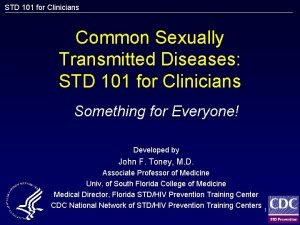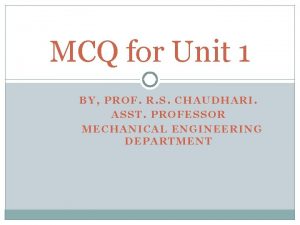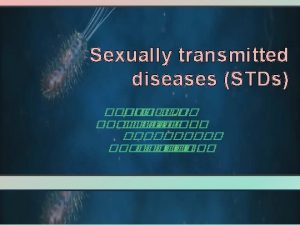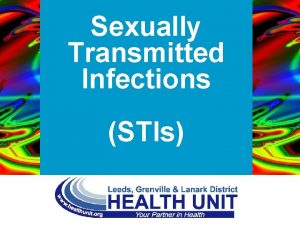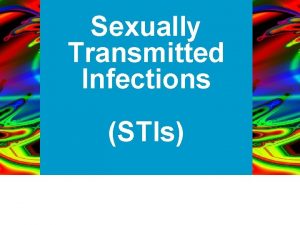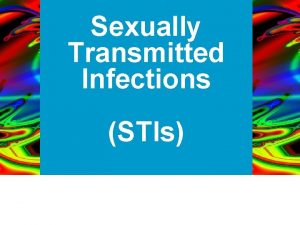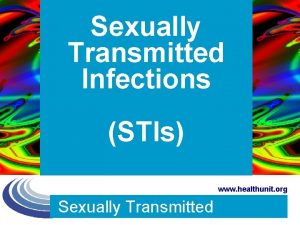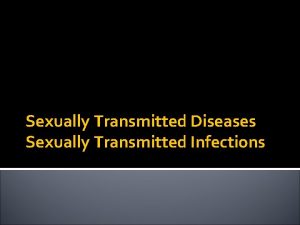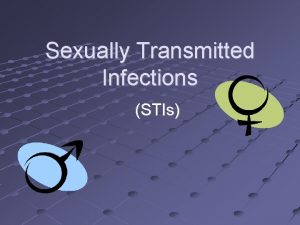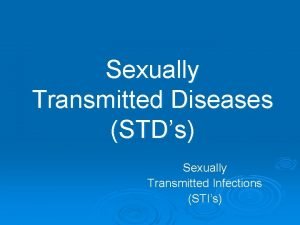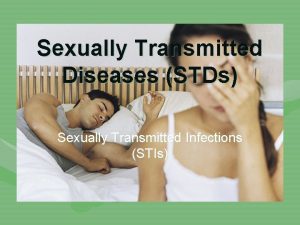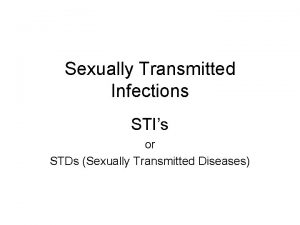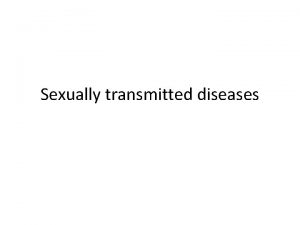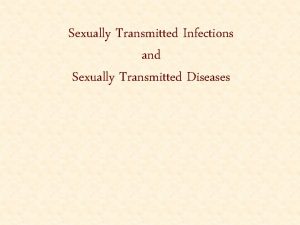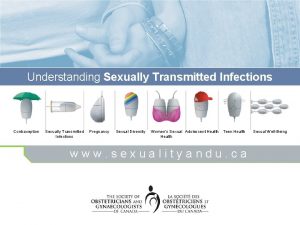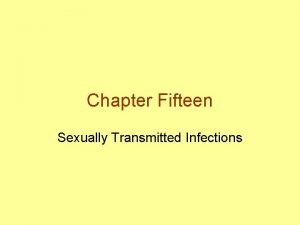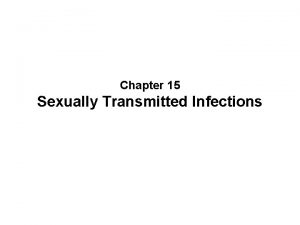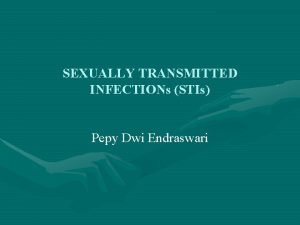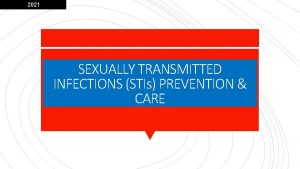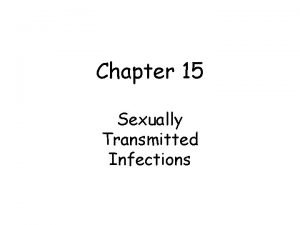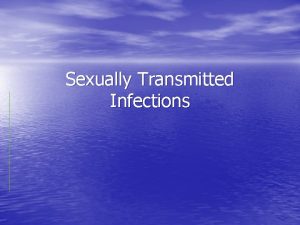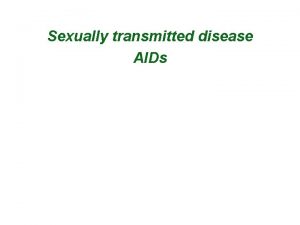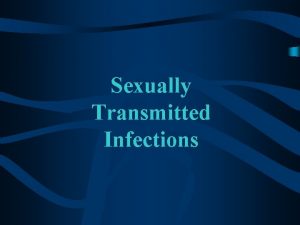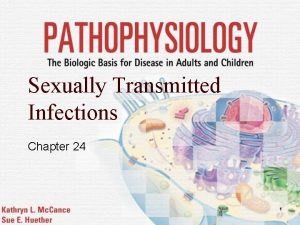Sexually Transmitted Infections STIs www healthunit org Sexually


























- Slides: 26

Sexually Transmitted Infections (STIs) www. healthunit. org Sexually Transmitted

Overview n n n Definition of STIs: “What are they? ” Transmission: “How are they spread? ” Types of infection: – Bacterial (Chlamydia, LGV, Gonorrhea, Syphilis) – Viral (HSV, Hepatitis B, HIV, HPV) – Parasitic (Pubic lice, scabies, trichomoniasis) n n Prevention: “How can I protect myself? ” Testing: “Where can I go for help? ” www. healthunit. org Sexually Transmitted

Sexually Transmitted Infections n Infections that are most commonly passed through sexual contact: • Oral • Vaginal • Anal • Skin-to-skin www. healthunit. org Sexually Transmitted

TRANSMISSION n In order for transmission to occur, it is necessary to have: – A body fluid with the germ in it – A way of spreading the germ from one person to another www. healthunit. org Sexually Transmitted

METHODS OF TRANSMISSION: Low Risk or No Risk § § § Abstaining Hugging Kissing Holding hands Dancing Sitting on toilets § Sharing lip balm § Mutual monogamy § Massage § Sharing forks, knives, etc. www. healthunit. org Sexually Transmitted

METHODS OF TRANSMISSION: High Risk § Sexual Intercourse § vaginal § anal § oral § Blood-to-blood contact § Sharing needles or other drug-use equipment § Tattoo or body piercing § Infected mother to her baby www. healthunit. org Sexually Transmitted

Bacterial vs. Viral STI’s n n n Bacterial STI’s include Chlamydia, gonorrhea & syphilis Can be treated and cured with antibiotics Untreated infection cause PID, infertility, & epididymitis n n Viral STI’s include HPV, HIV, Herpes, & Hepatitis B There is NO cure Medication available to treat symptoms only Can pass onto others for the rest of your life www. healthunit. org Sexually Transmitted

Chlamydia n n n The most common bacterial STI Greatest number of infections found in people 15 to 24 years old Untreated, it can affect the cervix and urethra, and occasionally the rectum, throat and eye 50% have NO symptoms - men and women Can be treated with antibiotics www. healthunit. org Sexually Transmitted

GONORRHEA n n n The 2 nd most common bacterial STI Most common in people aged 15 to 29 Can affect the cervix, urethra, rectum, throat, and occasionally the eyes Can be treated with antibiotics Often NO symptoms, especially in females www. healthunit. org Sexually Transmitted

GONORRHEA: Signs & Symptoms n Female – Increased vaginal discharge – Painful urination – Lower abdominal pain – Bleeding after sex and between periods – Pain during sex n Male – Thick, yellowishgreen discharge from penis – Painful urination – Testicular pain or swelling – Rectal pain, discharge or itching www. healthunit. org Sexually Transmitted

SYPHILIS n A bacterial infection that progresses in stages – Primary: (3 days – 3 months) starts as a small, painless sore called a chancre; goes away on it’s own – Secondary: (2 – 24 weeks) rash on the body, palms of hands & soles of feet, hair loss, feeling sick – Latent: lesions or rashes can recur www. healthunit. org Sexually Transmitted

SYPHILIS - Complications n Untreated syphilis may lead to tertiary syphilis, which can damage: – The cardiovascular system (heart & blood vessels) – The neurological system – Other major organs of the body – Complications may lead to death www. healthunit. org Sexually Transmitted

Genital Herpes (Herpes Simplex Virus - HSV) n Two types: HSV-1, causing cold sores, and HSV-2, causing genital herpes n It is a viral infection causing outbreaks of painful sores and blisters n Spread through direct vaginal, oral or anal sexual contact with an infected partner n Also transmitted by receiving oral sex from a partner with a history of cold sores n Symptoms can be treated with antiviral medications, but NO CURE www. healthunit. org Sexually Transmitted

Genital Herpes – Signs & Symptoms n n n Prior to an outbreak, the person may feel a tingling or burning sensation where the virus first entered the skin Painful sores (external or internal) Inflammation and redness Fever Muscular pain Tender lymph nodes www. healthunit. org Sexually Transmitted

Hepatitis B (HBV) n n Virus that attacks the liver Most infected people (90%) naturally produce antibodies to fight the disease, but some develop chronic HBV and will carry the virus for the rest of their life Chronic infection can lead to liver damage, cirrhosis, and cancer There is NO CURE, but vaccination can prevent infection www. healthunit. org Sexually Transmitted

Human Papilloma Virus or HPV (Genital Warts) n n n One of the most common STIs About 75% of people will have at least one HPV infection during their lifetime There are over 100 types of HPV Low-risk HPV types cause genital warts High-risk HPV types may cause cancer of the cervix There is NO CURE, but vaccination is available to prevent certain types of HPV www. healthunit. org Sexually Transmitted

HPV – Signs & Symptoms n n Many people with low-risk types have no symptoms Other HPV types may cause: – Warts on vulva, cervix, penis, scrotum, anus or in the urethra – Itchiness – Discomfort and bleeding during sex www. healthunit. org Sexually Transmitted

HIV/AIDS n HIV is a virus that destroys the immune system over time, robbing the body of its ability to fight other infections and illnesses n Once the immune system is weakened, other infections occur and AIDS develops (the fatal stage of HIV infection) n The virus is present in blood, semen, vaginal secretions & breast milk www. healthunit. org Sexually Transmitted

HIV / AIDS – Signs & Symptoms n n n 2 to 4 weeks after exposure, some people experience mild flu-like symptoms that last a few weeks, then disappear Many people have NO symptoms until years after exposure The only way to know is to get TESTED! www. healthunit. org Sexually Transmitted

Pubic Lice & Scabies n n n Infections caused by parasitic infestations Pubic lice: tiny crab-like insects that nest in pubic hair & bite their host to feed on blood Scabies: mites that burrow below the surface of the skin to lay their eggs Can live for 1 – 3 days on bedding, towels and clothing Treated with medicated creams & lotions www. healthunit. org Sexually Transmitted

Pubic Lice www. healthunit. org Sexually Transmitted

Scabies mite www. healthunit. org Sexually Transmitted

STI Prevention n n n Abstain from sexual intercourse (only method that is 100% effective) Don’t share needles or other drug-use equipment Have only 1 mutually faithful, uninfected sexual partner Get tested for STI’s before having sex Use a latex condom Avoid alcohol & other drugs www. healthunit. org Sexually Transmitted

When should I get tested? n n Once you become sexually active, you need a check-up & STI testing once a year You also need an STI test if: – – – You didn’t use a condom or the condom broke Your partner has an STI Your partner is having sex with someone else You have ever injected drugs You or your partner have any STI symptoms You have been raped www. healthunit. org Sexually Transmitted

Where to go for help: n n n Parents Health Teacher Health Unit Clinic Family Doctor or Nurse Practitioner Walk-in-clinic Hospital Emergency Department www. healthunit. org Sexually Transmitted

Remember… …your medical information will always remain CONFIDENTIAL! www. healthunit. org Sexually Transmitted
 A bacterial std that usually affects mucous membranes
A bacterial std that usually affects mucous membranes Sexually transmitted diseases
Sexually transmitted diseases Nursing management of reproductive tract infection
Nursing management of reproductive tract infection Chapter 24 lesson 1 sexually transmitted diseases
Chapter 24 lesson 1 sexually transmitted diseases Std
Std Chapter 24 sexually transmitted diseases and hiv/aids
Chapter 24 sexually transmitted diseases and hiv/aids Opportunistic infections
Opportunistic infections Genital infections
Genital infections Storch infections
Storch infections Postpartum infections
Postpartum infections Eye infections
Eye infections Can methotrexate cause yeast infections
Can methotrexate cause yeast infections Nosocomial infections
Nosocomial infections Storch infections
Storch infections Retroviruses and opportunistic infections
Retroviruses and opportunistic infections Opportunistic infections
Opportunistic infections Acute gingival infections
Acute gingival infections Bone and joint infections
Bone and joint infections Genital infections
Genital infections Understanding the mirai botnet
Understanding the mirai botnet Infections opportunistes digestives
Infections opportunistes digestives The totality of learned socially transmitted behavior
The totality of learned socially transmitted behavior A song transmitted orally which tells a story
A song transmitted orally which tells a story In case of dynamometer function of counter weight is to
In case of dynamometer function of counter weight is to Electronically transmitted postal ballot system
Electronically transmitted postal ballot system Transmitted light examination in questioned document
Transmitted light examination in questioned document Cnidaria class
Cnidaria class




